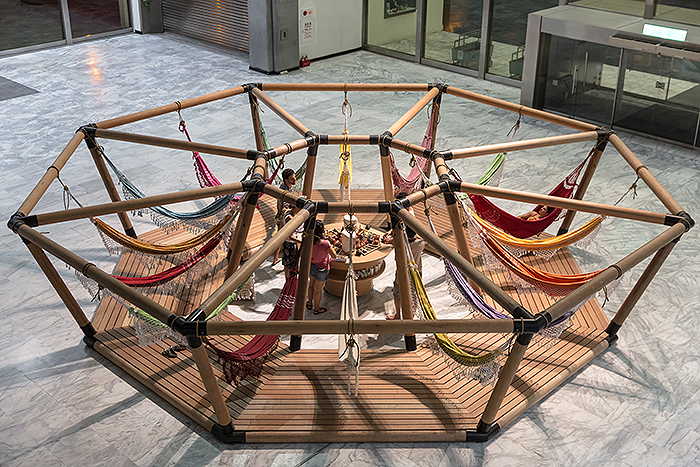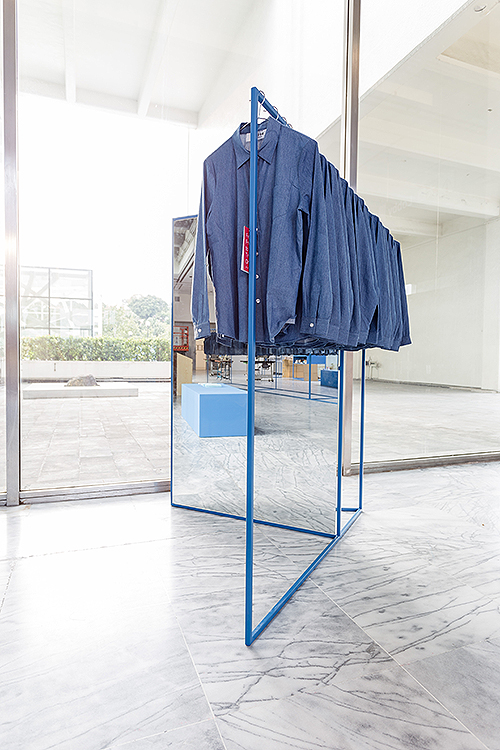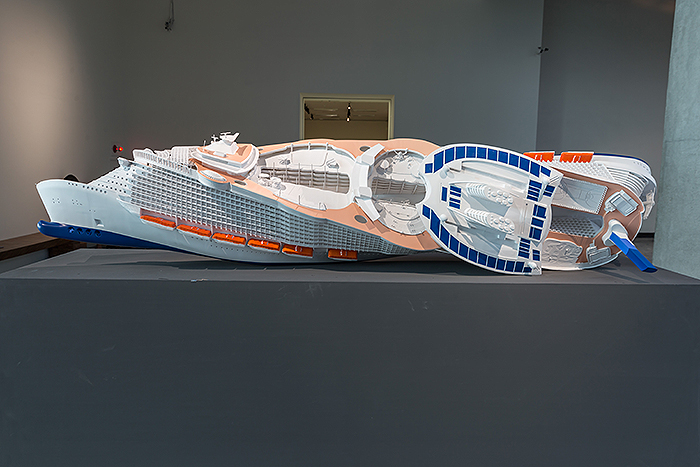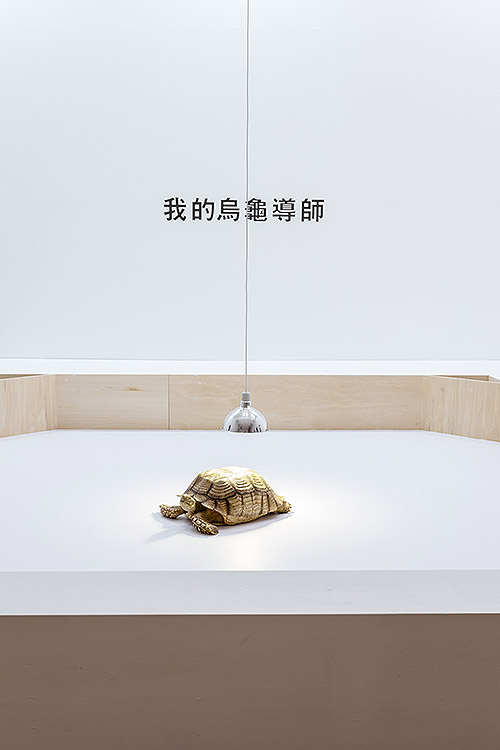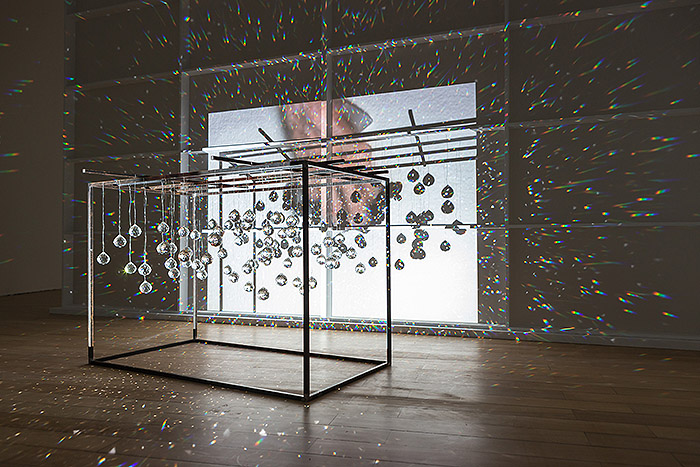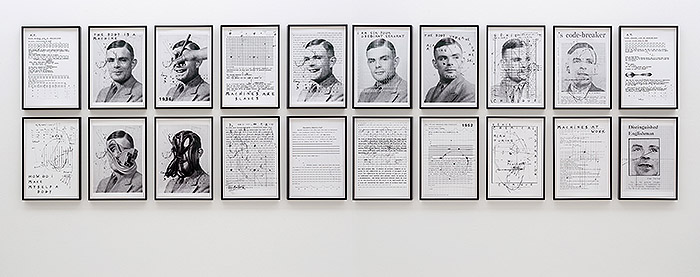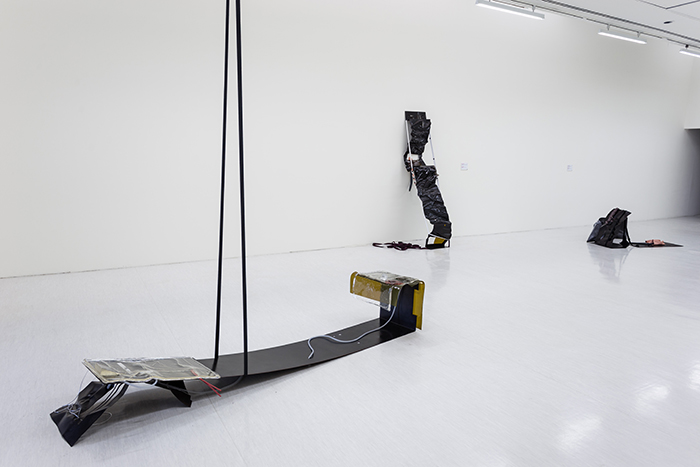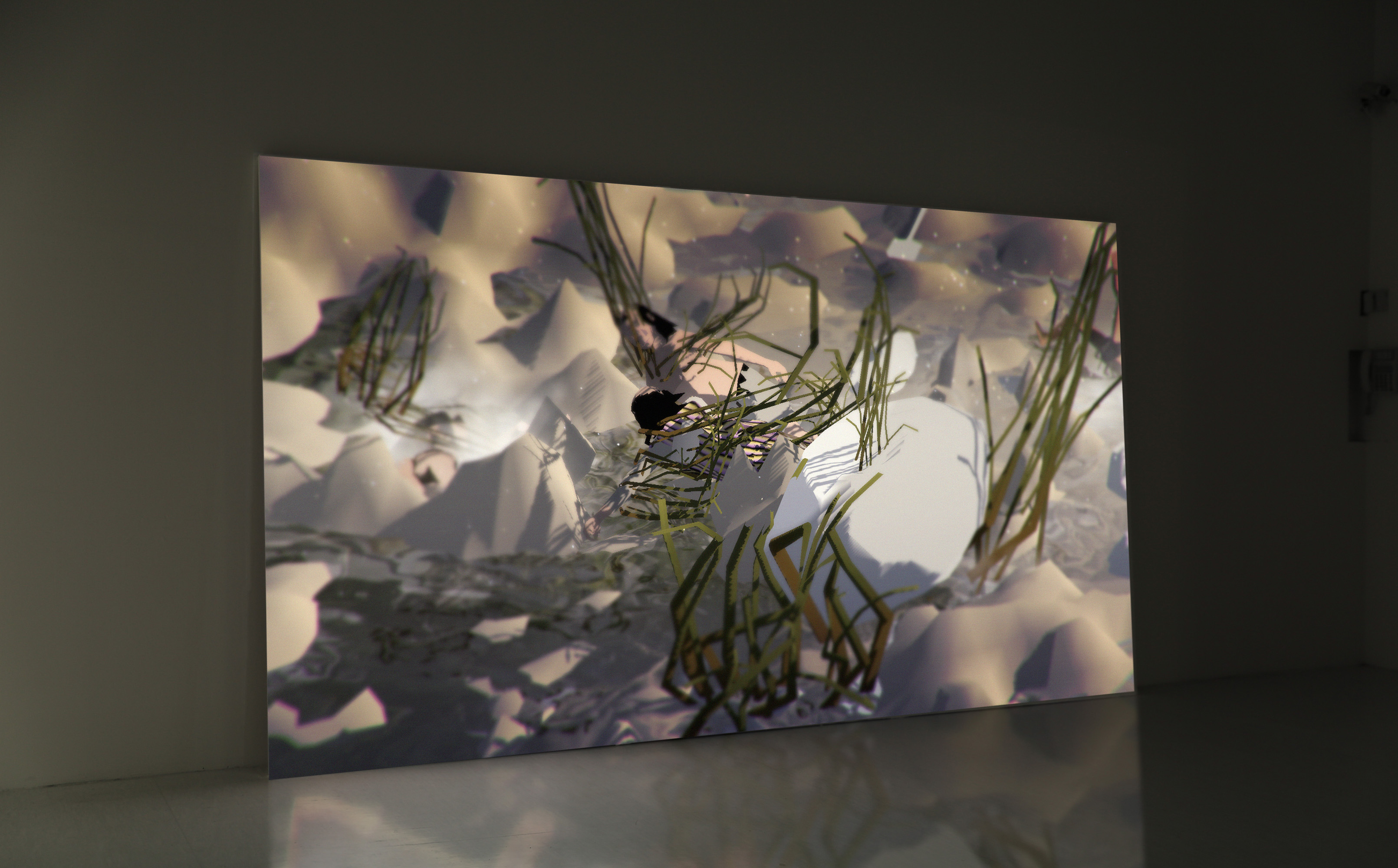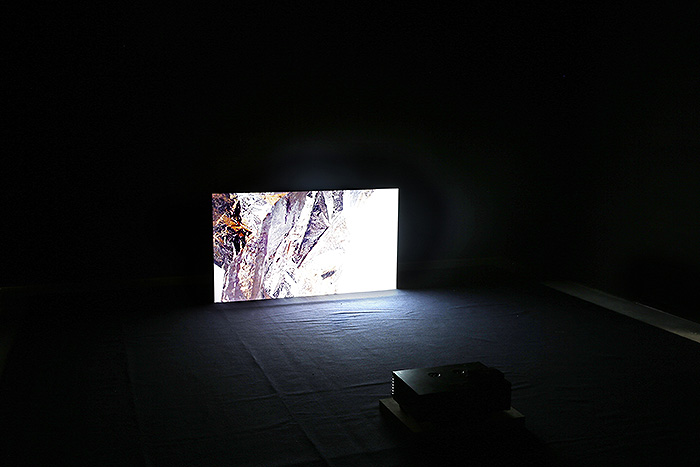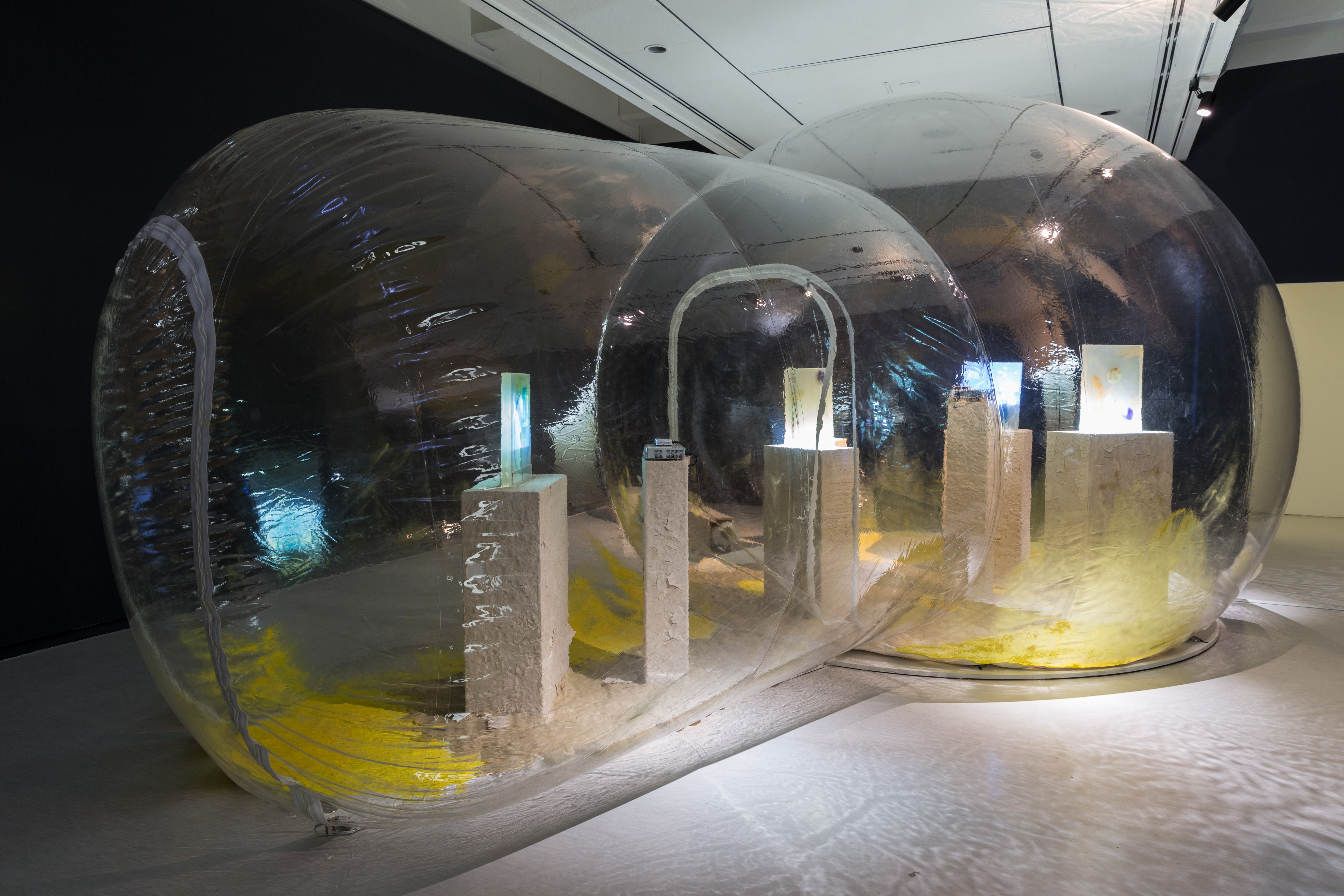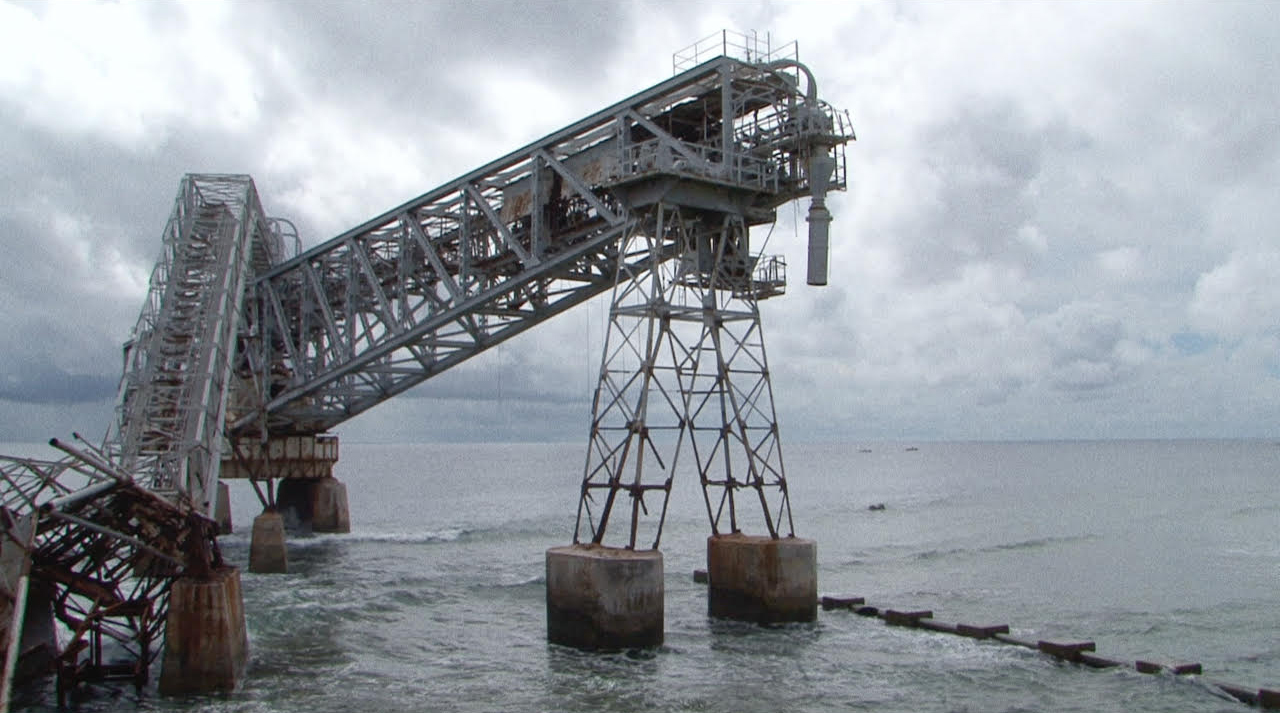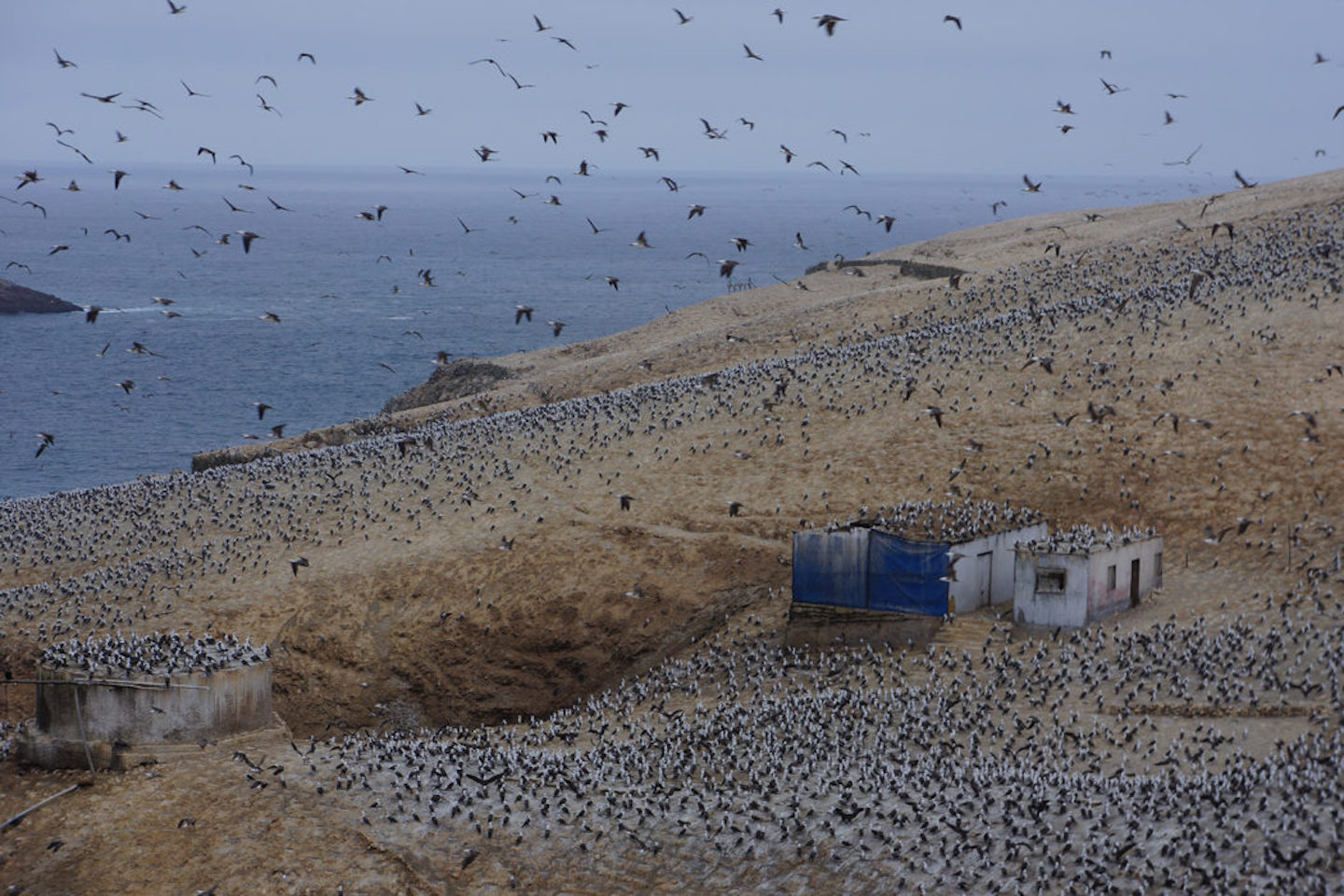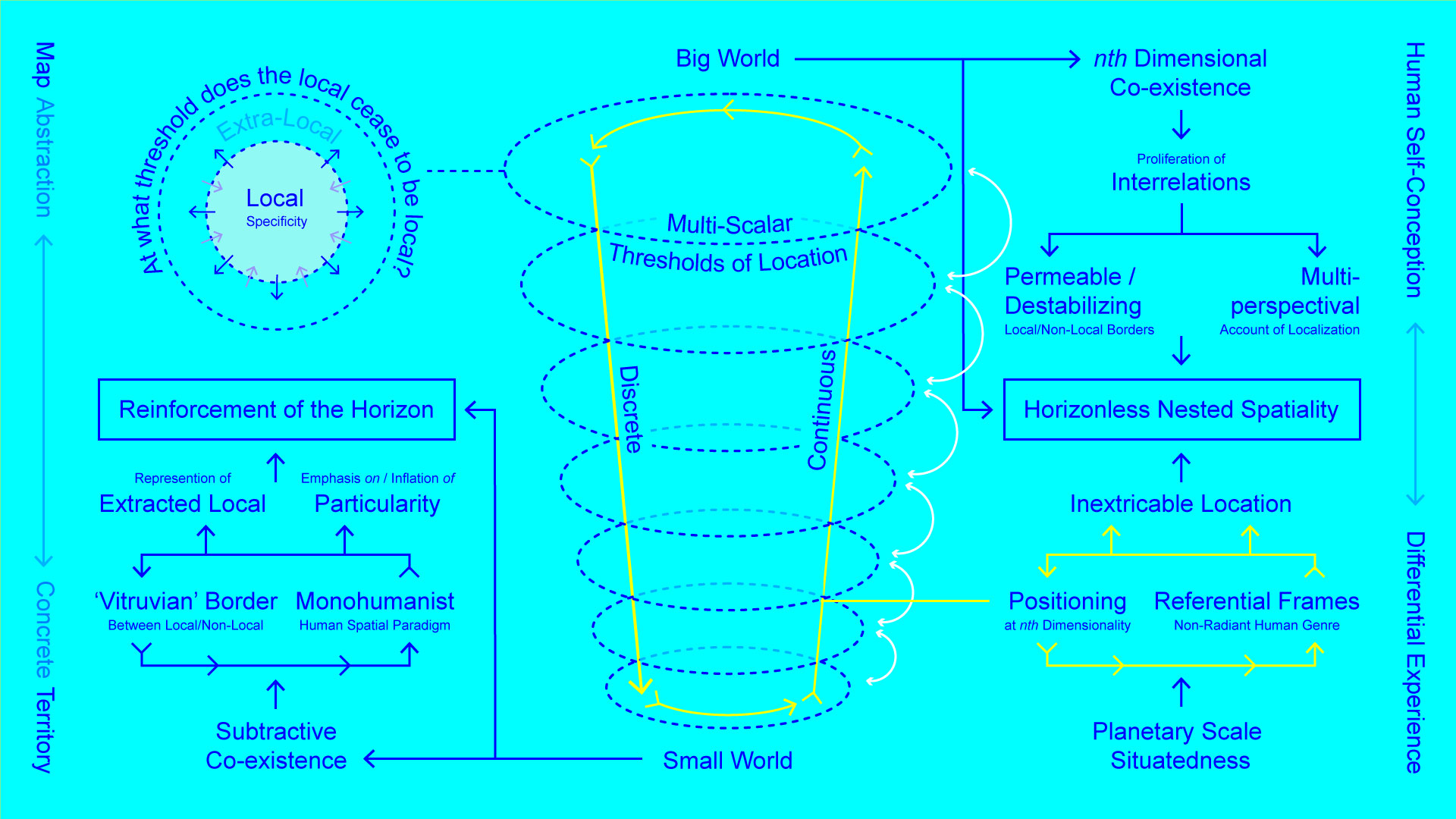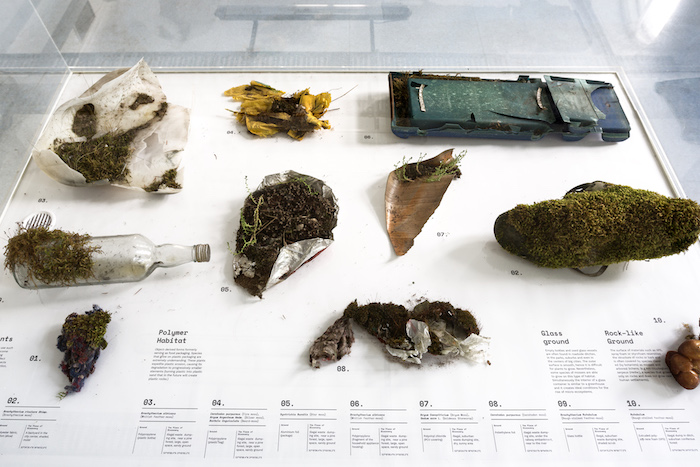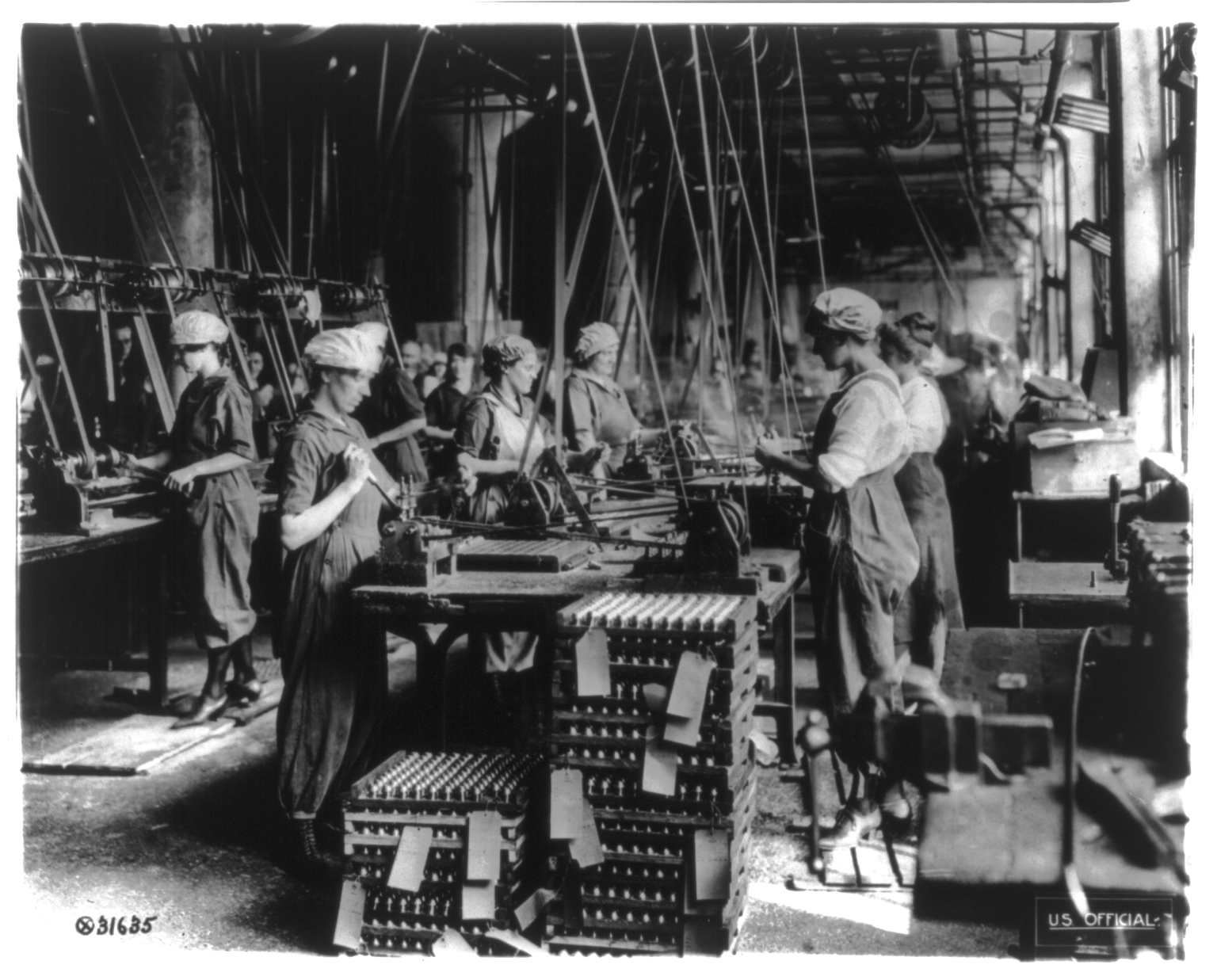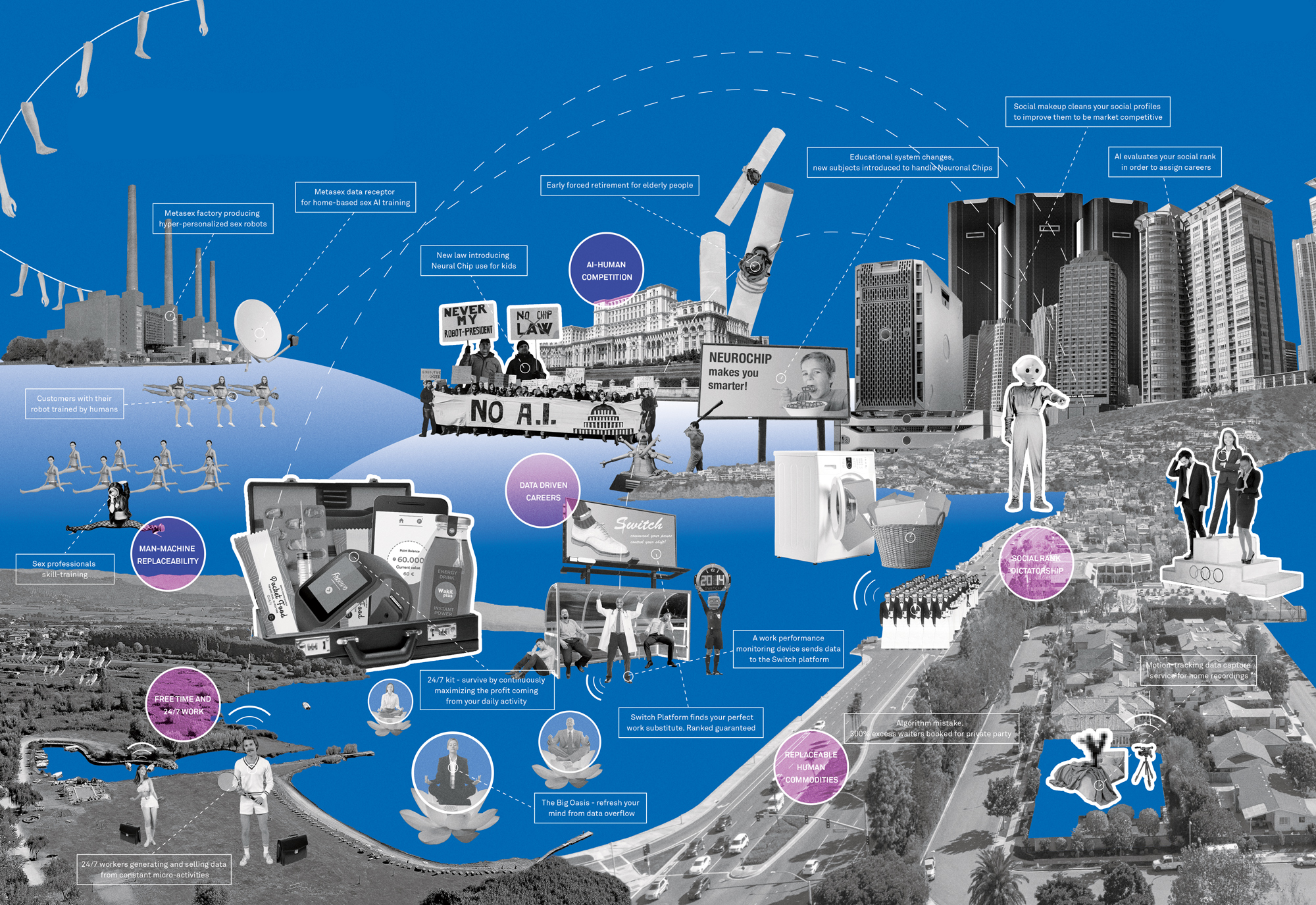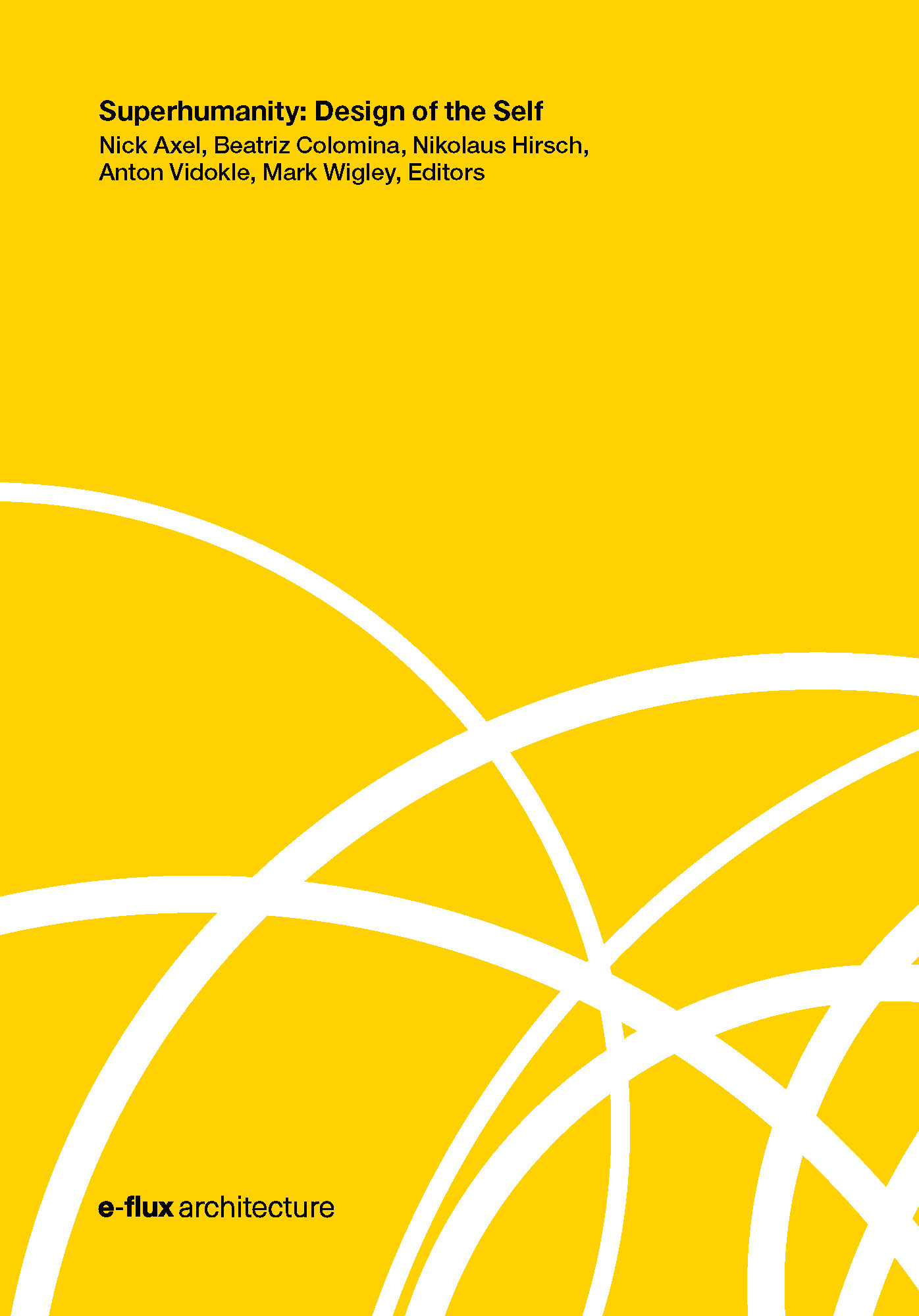September 13–January 4, 2015
“The Great Acceleration: Art in the Anthropocene,” curated by Nicolas Bourriaud, casts human subjects as both increasingly ghostly, stressing limitations and finitudes, as well more aligned with the organic, strange, and sensory. In other words: both more dead and more alive. These qualities have been thrown into relief by the ascendance of the machinic technologies and algorithmic logics that have come to condition much of our activity and attention. Expanding on these issues, the biennial, held solely at the Taipei Fine Arts Museum, features 52 artists and collectives, finely installed. As one might expect from Bourriaud, known for coining terms and corralling practices such as “relational aesthetics,” “postproduction,” and “altermodernism,” artistic approaches, rather than particular geographies, histories, or politics, connected the works in the exhibition.(1)
Formosa Decelerator (2014), an installation of hammocks linked in an octagonal structure with a tea service at the center, by the Rio de Janeiro collective Opavivará, opens the show. This is a mistake, as this convivial, relational work jarred with the cool, anxious tone of the rest of the works. Curatorially, however, it forms one side of an introductory quadrant around the museum’s central courtyard, framed by glass walls, behind each, it seems, a structural, industrial question nodding to how we arrived at the “anthropocene.”(2)
Perpendicular to idleness and rest, human and machine labor faced off across the square. Taiwanese artist Po-Chih Huang’s Production Line – Made in China and Made in Taiwan (2014) comprised a sewing space for finishing women’s denim shirts, which had been in part made at another production line at the 8th Shenzhen Biennale (each was overseen by a female member of the artist’s family), mirroring the industrial offshoring of the clothing industry that has dictated the movements of the artist’s mother throughout her working life. Opposite, Hung-Chih Peng’s army of 3D printers busily made parts for his sculpture The Deluge – Noah’s Ark (2014), a twisted boat invoking the disasters of climate change. Both works were a little didactic but usefully addressed the local industrial context and the outsourcing of manufacture that has marked Taiwan indelibly.
Industrialization, globalization, artificial intelligence, climate change, and the limits of the human are thus established as causal base factors; the exhibition proper seems to begin with Inga Svala Thórsdóttir & Wu Shanzhuan’s prescient 1994 work Thing(s) Rights Declaration: annotated statements on human rights adapted for objects and things. Nearby, Marlie Mul’s “Puddle” series (2013)—floor-based sculptures of resin and sand resembling urban rain swimming with oil, and strewn with chewing gum, plastic, or other human remnants—suggest an unexpected form of material lingua franca for any urban subject, who can recognize other absentee members of the populous from their remainders, left communing with water and the street like wet jewels. Elsewhere, as further evidence of the hybrid substances that industry and nature have collaborated in coagulating, Chuan-Lun Wu’s collection of petroleum plastic objects washed up at sea appear close to Matheus Rocha Pitta’s Brazil (2013), a series of photographs of red meat scattered on red earth.
The atmosphere on this lower floor is tinted with apocalyptic tones of human desertion set in a landscape of wrecks and ruins, pointing to evidence of a civilization now past. Peter Buggenhout’s gigantic conglomerations of dead industrial machinery covered in dust and dirt, The Blind Leading the Blind (2014), create an elephant’s graveyard for the devices that built the modern world. Roger Hiorns’ series of sculptures installed high up (Untitled, 2012) depict primal forms or deities hewn from dirty, washed-up polystyrene.
Having surveyed what might be conceived of as a skew on the art historical genre of landscape, creatures and subjects begin to appear on the upper two floors of the museum. The “encounter” with the other is staged, most obviously, in Shimabuku’s My Teacher Tortoise (2011–14), a beautifully gnarled tortoise, shiny of shell, placed in a minimal living environment, its slow reptilian movements appearing as some prehistoric presence, inaccessible. It’s worth pointing out, however, that more than presenting some spiritualist wisdom of creaturehood, the work dramatizes the moment one holds up an iPhone to take a picture of the animal, essentially filling the unbridgeable gap between the self and the other with a different form of witness. For conveying the ecstasy of encounters with the natural world, Joan Jonas’s new installation of Reanimation II (2010–13) is a smart choice; her exploded, multiscreen documentations projected an overwhelming encounter with a glacier onto Japanese screens through hanging crystals. Goats peer into Jonas’s camera lens, again offering us the abyss of the animal gaze, but Jonas’s accompanying voice and the splintering of her images into refractions suggest that such encounters are themselves gloriously shattering, each moment a kind of grappling.
Occasionally, there is a sense that Bourriaud is cycling through past ideas. As well as touches of “relational” works, the globalized, mash-up modernisms from exhibitions such as 2009’s “Altermodern” rang false in this context. However superficially Charles Avery’s brooding drawings (“Untitled” series) or Shezad Dawood’s Towards the Possible Film (2014) appear to fit the bill via science fiction and fantasy, these inward-looking works are more about building imaginative worlds rather than addressing the conditions of this one.
The melancholic biography of Alan Turing’s sexual life, as represented in several of Henrik Olesen’s A.T. collages (2012), make a welcome remark on the politics of the human subject, beautifully realized in the contrast between Turing’s handsome, awkward face, and the exciting yet tyrannical binary code of zeros and ones that ceaselessly appear alongside the thick black scrawls of “Machines are slaves” or “I am Sir, your obedient servant.”(3) Looping grey cables over Turing’s face take on a strangely visceral, quasi-sexual nature that appears both flesh and not, both an intelligent living body and not.
Such affective signal jamming between the organic and industrial, proposing a sharing of energies between both is picked up in Alisa Baremboym’s unsettling, seductive sculptures, where, on the third floor, “The Great Acceleration” hits a stride. Each named after a corporate-sounding portmanteau, such as Parasorbal Systems or Hidralink Systems (both 2014), and structured around black, conveyer-belt sized ribbons of chewed up, mangled steel, these sculptures are draped with printed silks and skin-like unfired ceramics, occasionally featuring socket-like orifices which slowly suck up quivering emollient gels.
It was around this point that the exhibition really begins to say what it means about a reconfiguration of the spheres of being. In a panel discussion during the opening days of the biennial, the curator mentioned that the simultaneous presentations in Paris of Philippe Parreno at Palais de Tokyo and Pierre Huyghe at Centre Pompidou inspired him, for their contrapuntal investigations of living vitality and deathliness via the robotic and ghostly and the conspicuously alive, respectively. While those artists are absent, here we have Ian Cheng’s Droning Like an Ur (2014), an endless simulation of animated videogame characters stripped from their environments, lost and uprooted; Rachel Rose’s video work Sitting Feeding Sleeping (2013) that ruminates on our intense proximity to forms of near-life, including cryogenically frozen bodies, animals and robots; whilst Anicka Yi’s Le Pain Symbiotique (2014) is a transparent PVC dome, readable as a giant, synthetic stomach. Inside, objects encased in glycerin glow ominously on plinths covered in dough and powder, festering in a preserved entropic state—a fine border separating a breathing biosphere from a cold, dead darkness.
1) For more information see Bourriaud’s publications Relational Aesthetics (Dijon, Presse Du Réel, 1998); Postproduction (Berlin, Lukas & Sternberg, 2007); and Altermodern (London, Tate Publishing, 2009).
2) Indeed, at first blush, it looked like this exhibition might have been a great theoretical mash-up. The full title—“The Great Acceleration: Art in the Anthropocene” alone raised two specters of recent theories, accelerationism and the anthropocene, that have found footholds in artistic discourse, while the curator’s opening notes additionally gave nods to speculative realism, object-oriented ontology, and animism, among other philosophical approaches. In the exhibition texts, however, Bourriaud tends to point to these theories, sometimes with overt ambivalence, rather than use them in practice.
3) The British codebreaker was subject to chemical castration following his conviction for indecency in 1952, after having a sexual relationship with another man, and allegedly committed suicide by cyanide poisoning.
